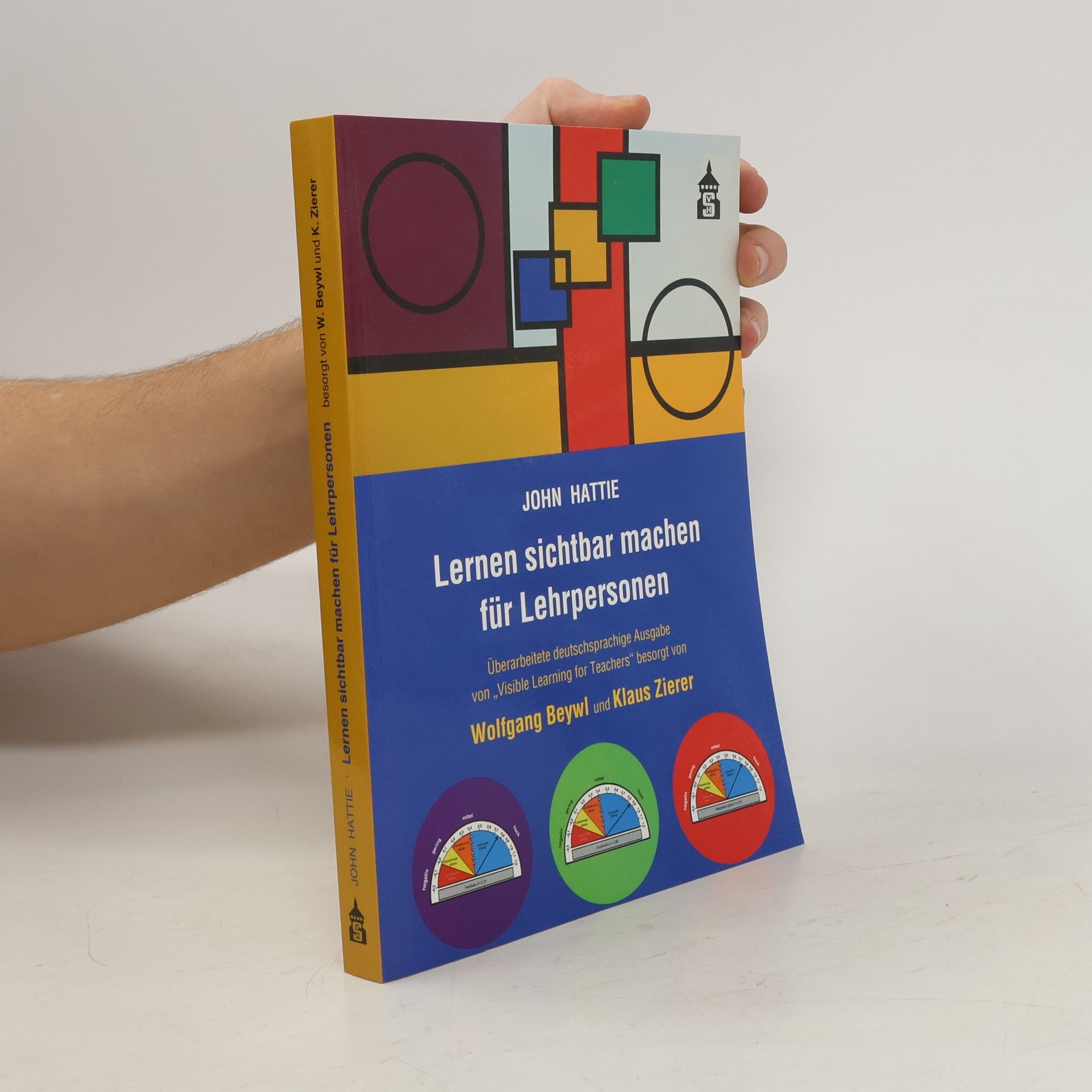John Hattie Bücher
John Hattie ist ein anerkannter Bildungsprofessor, dessen Arbeit sich auf die Erforschung der Effektivität von Lehre und Lernen konzentriert. Sein Ansatz basiert auf Datenanalyse und Evidenz, mit dem Ziel, Methoden zu identifizieren, die die größten Auswirkungen auf die Schülerergebnisse haben. Hattie's Forschung liefert Pädagogen praktische Einblicke, wie sie ihre Unterrichtsstrategien zur Verbesserung der Lernergebnisse optimieren können. Seine Arbeit ist entscheidend für ein modernes Verständnis effektiver Bildung.






John Hattie fasst in seinem epochalen Werk den weltweit verfügbaren Wissensstand zu schulischen Leistungen zusammen. „Visible Learning“ wurde 2009 nach 15 Jahren Arbeit veröffentlicht und enthält eine Synthese von über 800 Meta-Analysen, die auf mehr als 50.000 Studien mit etwa 250 Millionen Lernenden basieren. Dies macht es zum umfangreichsten Versuch, empirische Forschungsergebnisse zum Lehren und Lernen systematisch darzustellen. Hattie identifiziert 138 Faktoren, die unterschiedlich stark mit Lernleistungen interagieren, und zieht daraus Schlüsse für die zukünftige Gestaltung von Schule und Unterricht. Die Bedeutung des Werkes zeigt sich in den zahlreichen positiven Rezensionen aus der erziehungswissenschaftlichen Forschungsgemeinschaft sowie in der Resonanz in Massenmedien. Um dieses Werk einem breiten Publikum zugänglich zu machen, haben Wolfgang Beywl und Klaus Zierer in Zusammenarbeit mit Hattie eine deutschsprachige Ausgabe erstellt. Diese umfasst zahlreiche Überarbeitungen, klärt unklare Bezüge, ergänzt fehlende Abbildungen und korrigiert fehlerhafte Statistiken. Eine textkritische Einleitung beleuchtet die Rezeption in der Scientific Community, und eine Webseite bietet zusätzliches Material. Die Ausgabe richtet sich an Studierende, Lehrpersonen, Schulleitende, Bildungsforscher und Bildungspolitiker sowie an alle, die sich für die Erfolgsbedingungen von Bildung in schulischen Kontexten interessieren. Sie soll die kri
Visible Learning 2.0
John Hattie - Deutschsprachige Ausgabe von Visible Learning: The Sequel
Kenne deinen Einfluss!
"Visible Learning" für die Unterrichtspraxis
„Visible Learning“ von John Hattie ist die größte Sammlung empirischer Daten über die Erfolgsfaktoren von Schule und Unterricht. Das zentrale Ergebnis zeigt, dass der entscheidende Faktor für Bildungserfolg in den Haltungen der Lehrpersonen liegt: Wichtiger als das, was sie tun, ist, wie und warum sie es tun. Hattie definiert die Haltungen erfolgreicher Lehrpersonen als essenziell für pädagogische Expertise. In „Kenne deinen Einfluss! ‚Visible Learning’ für die Unterrichtpraxis“ wird dieser Gedanke vertieft. John Hattie und Klaus Zierer erläutern anhand von zehn Haltungen, wie erfolgreiche Lehrpersonen denken und handeln und welche Auswirkungen dies auf ihre Lernenden hat. Sie laden Lehrpersonen, Lernende, Eltern und Bildungspolitiker ein, die nächsten Schritte der „Visible Learning Story“ zu erkunden – eine Geschichte über Schulen, in denen pädagogische Expertise sichtbar ist und alle Beteiligten zusammenarbeiten, um Bildungserfolg zu ermöglichen. Das Buch folgt evidenzbasierten Kriterien für erfolgreiches Lernen und Lehren: Jedes Kapitel beginnt mit einem Haltungsfragebogen, gefolgt von einer Vignette und Zielangaben. Es präsentiert zentrale Ergebnisse aus „Visible Learning“ und belegt diese mit Beispielen aus dem Schulalltag. Zudem wird erläutert, wie man Lernen sichtbar machen und die eigene Professionalität weiterentwickeln kann, abgerundet durch Checklisten und Übungsaufgaben.
The global expansion of education is one of the greatest successes of the modern era. More children have access to schooling and leave with higher levels of learning than at any time in history. However, 250 million+ children in developing countries are still not in school, and 600 million+ attend but get little out of it – a situation further exacerbated by the dislocations from COVID-19. In a context where education funding is stagnating and even declining, Arran Hamilton and John Hattie suggest that we need to start thinking Lean and explicitly look for ways of unlocking more from less. Drawing on data from 900+ systematic reviews of 53,000+ research studies – from the perspective of efficiency of impact – they controversially suggest that for low- and middle-income countries: This groundbreaking and thought-provoking work also identifies a range of initiatives that are worth starting. It introduces the Leaning to G.O.L.D. methodology to support school and system leaders in selecting, implementing, and scaling those high-probability initiatives; and to rigorously de-implement those to be stopped. It is essential reading for anyone with an interest in education.
The Conservation and Restoration of Paintings
- 157 Seiten
- 6 Lesestunden
Provides a comprehensive guide to the conservation and restoration of paintings. It includes details of techniques, materials used in both the original paintings and in restoration, chemical formulas, equipment and methods of handling and storage; it also recounts the ways in which many common pitfalls can be avoided, and gives other practical tips based on the author's 30 years of experience.
The Purposes of Education
- 272 Seiten
- 10 Lesestunden
The encounter -- Does educational data speak for itself? -- Is learning a visible phenomenon? -- Is it important to teach and learn specific subjects? -- How not to objectify the students and pupils you are studying? -- What is the role of the teacher? -- What is the relationship between educational research and educational politics? -- Is it possible to revitalize the German concept Bildung, i.e. the formation of character and the higher ideas and ideals of education? -- How to differentiate between the how, what, and why of education -- Is there a purpose of education? -- Is it possible to understand pedagogy as an art of decentering? -- How to deal with neuroscience? -- How to deal with critique? -- If schools didn't exist - would we miss them? -- Why are we longing for predictability and security? -- The conversation stops but must continue.
John and Kyle Hattie offer a 10-step plan to nurturing curiosity and intellectual ambition and providing a home environment that encourages learning. These steps based on the strongest of research evidence and packed full of practical advice can be followed by any parent to support learning and maximise the potential of their children.
Collective Student Efficacy
- 184 Seiten
- 7 Lesestunden
This book is based on one of the most important influences on student learning: teachers who believe that they can improve their students' achievements. Along with this, the book explores the notion that this powerful belief can also exist between students, enhancing their achievements but also preparing them for real world encounters and job demands.